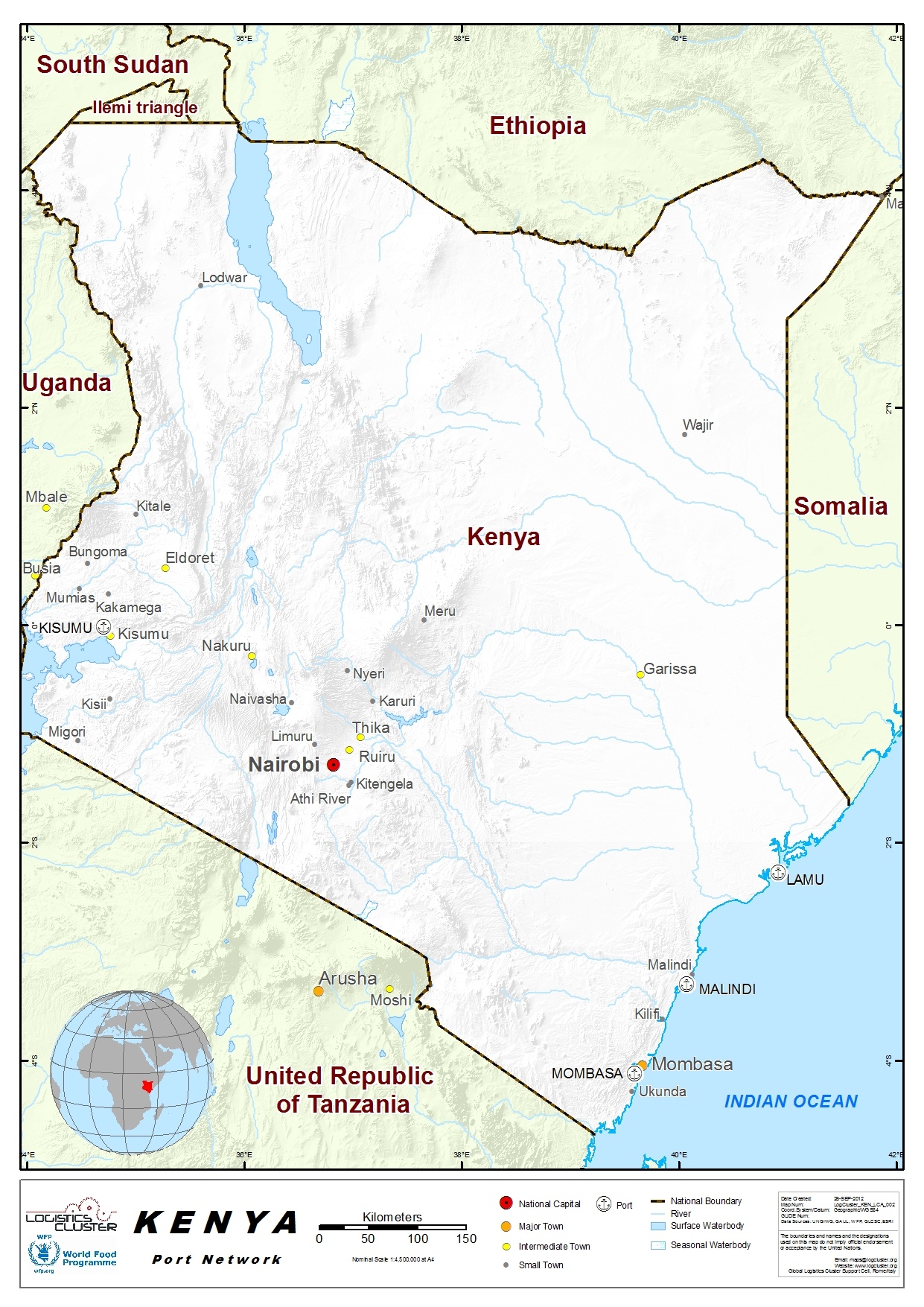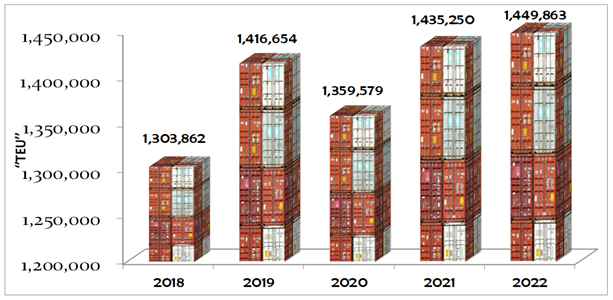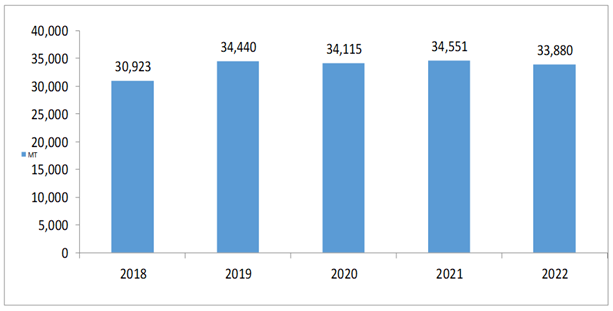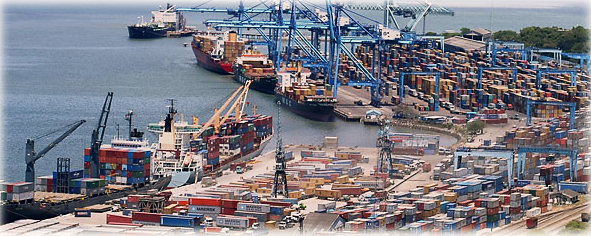2.1 Kenya Port Assessment
Port Assessment
There are about 15 ports in the country and most of these are undergoing expansion and renovation to meet global standards. The main ports are Mombasa, Lamu and Kisumu Port. The rest are classified as small ports
Mombasa Port - Situated on the East African Coast, is not only the premier port of Kenya but the largest and the busiest port of the Eastern African region. Mombasa Port comprises the Kilindini Harbour, Port Tudor, Port of Reitz, and the Old Port plus the waters surrounding the island of Mombasa. The port has a total of 19 berths with a quay length of 4200 metres. Six berths are container terminals, 13 for conventional cargo, one crew ship terminal, 2 oil terminals and Mbaraki wharf and Old Port. The annual handling capacity of the port is 2.65 million TEU’s. It is managed and operated by the Kenya Ports Authority that also offers pilotage, docking, anchorage, stevedoring. Shipping, transport, and storage services are given by private enterprises.
Port of Lamu - The Port of Lamu was commissioned in May 2021. It has 3 complete berths with a quay length of 1200 metres and when complete the port will have a total of 23 berths. KPA (Kenya Ports Authority) has deployed 5 mobile harbour cranes. Currently it has a warehouse that can accommodate 10,000 tonnes. There is a police station inside the port, KPA security and patrol by Kenya Defence Forces. KPA is also constructing a water desalination plant for use by port and serve surrounding community. 
Kisumu port - located in Kisumu County is critical in connecting Kenya, Mwanza and Bukoba in Tanzania and Port bell in Uganda through lake transport. It facilitates multimodal cargo transport from rail, road, and water. It handles both containerized and conventional Cargo as well as pedestrians. It has a capacity to handle 50,000 TEUs or an equivalent of 200,000 metric tonnes. It consists of a 352m long quay wall in an L-shape, and a draft of 2.5m to 3.5m. The port has a yard area of 58,428 metre square for handling TEUs and conventional cargo. KPA plans to increase the port capacity in line with the increase in cargo and passenger freight across the East African community. The port has recorded steady growth in the last 5 years following its rehabilitation by the government of Kenya in 2019-2023. Volume of cargo has grown 3,431 tonnes in 2017 to 54,014 tonnes in 2021 (grown 15 times) while the number of vessels docking at Kisumu Port has increased 7 vessels in 2017 to 77 vessels in 2021 (grown 7 times).
Kilifi Port is situated on Kilifi Creek and has a boatyard. The port area is sheltered and has a bridge. It also offers marine services. KPA aims to develop it further and construct a dock for handling fish and build Luxury Marine Buildings plus 200 mooring points for all kinds of ships.
Port of Mtwapa is a small port and receives smaller yachts and ships. Also, there is not much space for expanding this port. However, plans are underway to develop it further to make it a fishing port equipped with a fish landing facility.
KPA is now constructing a land point for fish and some berths.
Port of Shimoni is in Shimoni opposite Wasini island on the southern coast of Kenya. It handles about 10,000 metric tonnes of cargo and is the busiest of the small ports in terms of coastal trade. It has a dock, used primarily for fishing and tourism. It also has a deep and well-sheltered bay that can accommodate large ships. Currently KPA is constructing a new jetty to handle fish, general cargo, and passengers.
Port of Malindi is located on the northern side, just 120 km away in Mombasa town. It has a dock that is in good condition however due to accretion, the breaking area has drifted to the fish handling part of the port. Its anchorage is 11 m to 12.2 m, and it can accommodate vessels measuring up to 500 m. This port exports cotton, sim-sim, and copra. It also serves the fish industry and has scope for expansion to revamp the dock to make it an efficient fishing port and a tourist spot, as the Malindi town is a popular tourism destination. Currently, the fish jetty handles about 1,250 MT (Metric Tonnes) annually and sees 8000 tourist vessels. KPA has also decided on expanding this port by acquiring an additional 2500 sqm of land area to construct administrative and office buildings, cold storage for fish, ice facility, fuel services, ship repair etc.
Port of Kiunga is a dock near the Village of Kiunga that deals with 2500 MT of fish annually and coastal trade that comprises 1000 MT of cotton and coconut exports. This jetty has poor sea access, and the KPA is planning to take 20 acres of land to develop this port into an efficient fishing port that would boost the fishing sector. It also plans to dredge the water channel and construct another wharf that has easy access to the waters. The port would also have offices and buildings apart from a cold storage facility for keeping seafood.
https://www.marineinsight.com/know-more/9-major-ports-in-kenya/
Kenya - 2.1.1 Port of Mombasa
Kenya - 2.1.2 Kenya Port of Lamu
Port Overview
Port of Lamu came into being as an alternative port to complement the existing Port of Mombasa as contained in Economic Sessional Paper Number 10 of 1965. It is one of the flagship infrastructure projects identified by the Government in Kenya Vision 2030. It is part of the development of a new transport corridor linking a new and modern Port of Lamu with Garissa, Isiolo, Maralal, Lodwar and Lokichogio and branching at Isiolo to Moyale at the border with Ethiopia and proceeding to the border with Southern Sudan. This development will include the long-term physical planning of Lamu Metropolis area and once completed, the corridor will comprise of.
-
Standard gauge railway line
-
Special Economic Zone (SEZ)
-
Warehousing facilities
-
Road network
-
Oil pipeline (Crude & product)
-
Oil refinery (Isiolo/Lamu)
-
International Airports (Lamu, Isiolo and Lokichogio)
-
Port at Lamu (Manda Bay).
-
Resort cities (Lamu, Isiolo and Lake Turkana)
The LAPSET Corridor
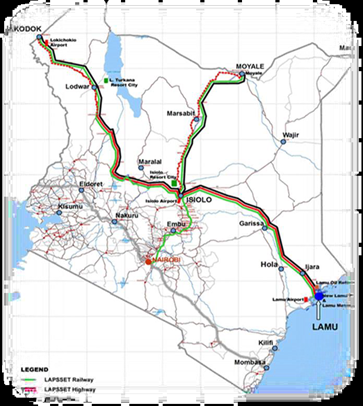
Project Description
The proposed port site at Kililana in Manda Bay at 40o 55' East and 2o 11' South was selected because it has deep and sheltered bay and a wide navigable entrance channel. Hydraulic and geotechnical surveys have confirmed that the area is suitable for port construction. The projected 10Km shore length has the capacity to accommodate up to Twenty-Three (23) berths each with a length of 400 m.
The Port has two harbour channels:
-
Southern Channel (Sub channel) Dredge depth of 12.5m & 300m wide
-
Eastern Channel (Main Channel) Dredge depth of 17.5m & 600m wide
Project Benefits
The port is expected to attract larger cargo ships and aims to provide benefits within the region by passing on savings derived from lower marine costs due to faster ship turnaround time and at the same time of reducing the cost of doing business.
More information and updates on the project can be found at:
Kenya Vision 2030 Website
Wikipedia Port of Lamu Website
https://www.kpa.co.ke/OurBusiness/pages/lamu.aspx
Port website: https://www.kpa.co.ke/OurBusiness/pages/lamu.aspx
Key port information may also be found at: http://www.maritime-database.com.
|
Port Location and Contact |
|
|---|---|
|
Country |
Kenya |
|
Province or District |
Lamu County |
|
Nearest Town or City with Distance from Port |
Mombasa 341 km |
|
Port's Complete Name |
Port of Lamu |
|
Latitude |
2° 16' 5" S |
|
Longitude |
40° 54' 9" E |
|
Managing Company or Port Authority
|
Kenya Port Authority |
|
Management Contact Person |
Managing Director - Capt. William K. Ruto |
|
Nearest Airport and Airlines with Frequent International Arrivals/Departures |
Manda Airport Jambo jet - Nairobi–Jomo Kenyatta Safari link - Kiwayu, Nairobi–Wilson Skyward Express - Mombasa, Nairobi–Wilson |
Capacity of the terminal
The first three berths of Lamu port are completed with marine salvage operation (LOF) and Marine Terminal (MT).
Total Quay length 1.2km, Water depth: 17.5m at Lowest Tide (LAT) and 20.5m at High tide
STS span is 30.5m from seaward to landward rail, 1,200,000 TEUs Capacity 200 Reefer Points 3040m sq. Customs Warehouse.
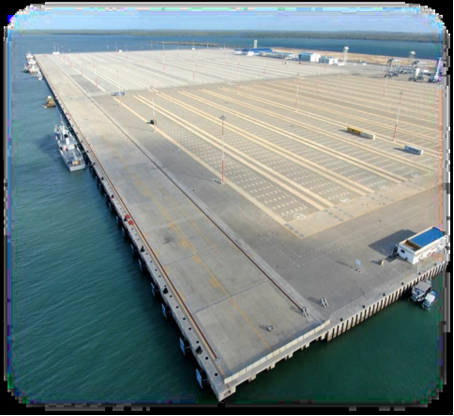
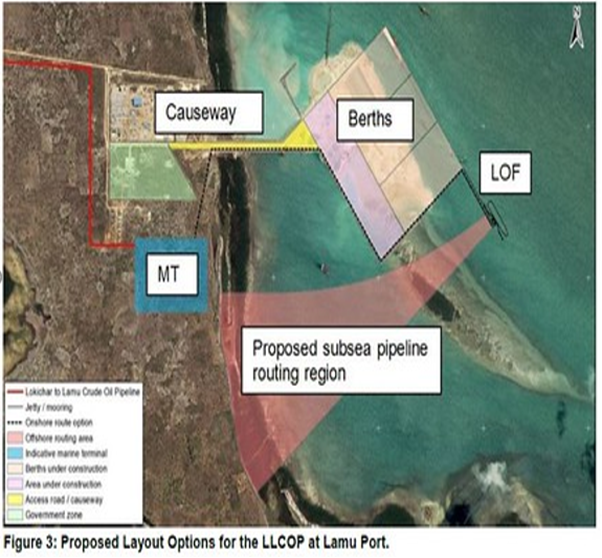
Key Milestones

-
Commissioning of the 1st Berth on 20th May 2021
Equipment
-
KPA deployed 5 harbour mobile cranes.
-
4 Rubber tyred gantry cranes
-
4 terminal tractors
-
one 25 mt forklift
-
Harbour tug for craft assistance (guiding ships in the harbour, berthing/unberthing, towage)
-
Pilot boat for compulsory pilotage services
-
Mooring boat for making fast the ship alongside berth.
-
One storage facility (shed) wit capacity of 3000mt.
|
Seasonal Constraints |
||
|---|---|---|
|
|
Occurs |
Time Frame |
|
Rainy Season |
No |
N/A |
|
Major Import Campaigns |
No |
N/A |
|
Other Comments |
|
|
|
Handling Figures as May 2023 |
|
|---|---|
|
Vessel Calls |
Not available |
|
Container Traffic (TEUs) |
3980 |
Conventional handling - 244.5 MT (Fishing 31.5) and 22,684 Livestock
Number shipments called Lamu 22
|
Handling Figures Bulk and Break Bulk for 2022 |
|
|---|---|
|
Bulk (MT) |
0 |
|
Break bulk (MT) |
0 |
Discharge Rates and Terminal Handling Charges
Port of Lamu is on Promotional Tariff.
Promotional Tariff in place to attract vessels and cargo (Transit & Transhipment traffic) to the new Port.
Marine Services
-
Call Based Dues (Light, Port & Harbour & Security Dues) charged once at the first port of call.
-
GT Based Dues (Pilotage, Tug Service, Mooring) charged 50% for the second port call.
-
RoRo, Pure Car Carriers and Passenger vessels charged 50% of the GT Based Dues
Cargo Handling Services
-
Stevedoring of cargo –40% discount
-
Stevedoring Coasters’ cargo – 40%discount
-
Shore Handling/Wharfage – 40%discount
Berthing Specifications
|
Type of Berth |
Quantity |
Length (m) |
Maximum Draft (m) |
Comments |
|---|---|---|---|---|
|
Conventional Berth |
|
450 |
17 |
can handle both containers and conventional |
|
Container Berth |
|
450 |
17 |
can handle both containers and conventional |
|
Silo Berth |
|
n/a |
n/a |
no silo yet |
|
Berthing Tugs |
|
1 |
1 |
available |
|
Water Barges |
n/a |
n/a |
n/a |
Not available |
General Cargo Handling Berths
|
Cargo Type |
Berth Identification |
|---|---|
|
Imports - Bagged Cargo |
Available |
|
Exports - Bagged Cargo |
Available |
|
Imports and Exports - RoRo |
Available |
|
Other Imports |
Available |
Port Handling Equipment
|
Equipment |
Available
|
Total Quantity and Capacity Available |
Comments on Current Condition and Actual Usage |
|---|---|---|---|
|
Dockside Crane |
Yes |
Not available |
Not available |
|
Container Gantries |
Yes |
Not available |
Not available |
|
Mobile Cranes |
Yes |
Not available |
Not available |
|
Reach stacker |
Yes |
Not available |
Not available |
|
RoRo Tug master (with Trailer) |
Yes |
Not available |
Not available |
|
Grain Elevator with Bagging Machines |
Yes |
Not available |
Not available |
|
Transtainer |
Yes |
Not available |
Not available |
|
Forklifts |
Yes |
Not available |
Not available |
Container Facilities
|
Facilities |
20 ft |
40 ft |
|---|---|---|
|
Container Facilities Available |
3 berths |
same for 20ft |
|
Container Freight Station (CFS) |
n/a |
n/a |
|
Refrigerated Container Stations |
200 |
same for 20ft |
|
Other Capacity Details |
as under equipment |
as under equipment |
|
Daily Take Off Capacity |
data no available |
data not available |
|
Number of Reefer Stations |
200 |
same for 40ft |
|
Emergency Take-off Capacity |
Give an indication |
Give an indication |
|
Off take Capacity of Gang Shift |
data not available |
data not available |
Customs Guidance
Customs clearance formalities start with shipping line lodging ship’s manifest with customs immediately before departure from the last port of call. Upon approval of manifest by customs, the Clearing agent can lodge an entry in the ICMS system for a consignment within the ship. The consignment is inspected by various relevant regulatory agencies and released by customs online after payment of the various duties. If exempted from duty, for exempted consignment approval is done online before final release. Upon clearing with customs, the agent proceeds to settle port charges and release consignment with KPA. Once completed, the port gives a “Pick up Order”/PUO which is effectively the gate pass to allow cargo exit from port. The whole clearing process takes on average 2 working days hence possible to have all clearance in place by time of ship arrival to facilitate direct delivery upon discharge.
For additional customs information, please see the following link: 1.3 Kenya Customs Information
Terminal Information
The terminal is multipurpose a can handle both conventional and containerised.
MAIN STORAGE TERMINAL
A warehouse storage shed is available and can handle 3000mt.
|
Storage Type |
Number of Storage Facilities |
Area (m2) |
|---|---|---|
|
Bagged Cargo |
one shed |
30 x40 |
|
Refrigerated Cargo |
Not available |
|
|
General Cargo |
animals and fresh products |
|
Stevedoring
Stevedoring activities in port constitute discharge and loading activities for containerised, loose/break bulk, bulk liquid grain etc. The port authority offers all stevedoring activities except for bulk grain which is handled by private. Liquid discharge/loading activities not applicable in Lamu for now
Hinterland Information
Goods are only released out of port after payment of all port dues, customs duties and when they meet other import conditions ascertained by other Government regulatory agencies. Exit from port and onwards into the hinterland is mainly by rail or road. There is more reliance on deliveries by road over 90%, due to decreased capacity of rail, run down infrastructure, and rolling stock.
To speed up evacuation from port to deter demurrage and punitive port storage charges, cargo is also shunted ex-port by trucks onto warehouses or transit yards out of port from where it is then dispatched either by road or rail to its destination in the hinterland.
Port Security
Kenya has implemented the maritime security requirements contained in Chapter XI-2 of the International Convention for the Safety of Life at Sea 1974 and the International Ship and Port Facility Security (ISPS) Code through the Merchant Shipping Bill 2004 and the Maritime Security Regulations 2004. These regulations apply to all seaports in Kenya and passenger ships, cargo ships of 500 GRT or more and mobile offshore drilling units on international voyages.
Security Level 2 applies in Kenyan territorial waters and seaports. Any change of security level or its area of application will be communicated by notices to mariners, navigational warnings, circulars, VHF communication or any other appropriate means.
Port Security in Kenya has been tightened considerably following the events of 11 September 2001 and the sharp rise in terrorist incidents worldwide and lately in Kenya. Until recently KPA was concerned mainly with cargo security. But now in common with other port authorities around the world KPA is focusing its attention on the security of everyone visiting its ports and using their facilities.
KPA has introduced several measures to make the port a safer place for business which includes:
-
New electronic surveillance equipment including CCTV.
-
A fully-fledged police station within the port headed by an Officer Commanding Police Division/OCPD Port.
-
Coastguard surveillance of waters in port area
-
New search and rescue centre set up jointly with the IMO to supplement sea surveillance.
-
Plain-clothes and uniformed security officers on patrol in port areas
-
Strict controls on port entry with all port users and visitors required to display biometric passes and to weigh reflector jackets when accessing the quayside.
-
Restricted entry to container terminal and other key sections such as oil terminals.
-
Continuously manned watch towers in car handling area and container terminal
-
A rapid response team to deal with urgent security matters in or near the port area.
-
A centralised verification area at the container terminal, car handling area and the CFS
-
Physical and electronic operated Barriers at port gates to deter forced entry and ensure proper security checks.
-
Mandatory scanning of all export containers.
-
Random targeting of import containers for scanning without stripping – thus helping to reduce pilferage.
|
Security |
|
|
|---|---|---|
|
ISPS Compliant (Yes / No) |
YES |
|
|
Current ISPS Level |
2 |
Level 1 = Normal, Level 2 = Heightened, Level 3 = Exceptional |
|
Police Boats |
1 |
|
|
Fire Engines |
4 |
|
Kenya - 2.1.3 Port of Kisumu
Port Overview
Kisumu port, which is positioned in Kisumu Central Constituency, in Kisumu Town, in Kisumu County, in Kenya is under the management of Kenya Port Authority (KPA). It is situated on the shores of Lake Victoria, the second largest freshwater lake in the world. The Port is one of the ports on Lake Victoria that offer organised shipping services on the Lake. The other ports are, Port Bell and Jinja in Uganda; and Mwanza, Bukoba, and Musoma in Tanzania. Out of these ports, Kisumu, Mwanza, and Port Bell are the largest, in terms of throughput. Inland shipping on Lake Victoria forms a vital component of an intermodal supply chain along the Central and Northern Corridor linking to Mombasa and Dar es Salaam ports. The port links Kisumu to Port Bell in Uganda and Mwanza in Tanzania, using rail ferries that carry rail wagons loaded directly from rail tracks in the three ports.
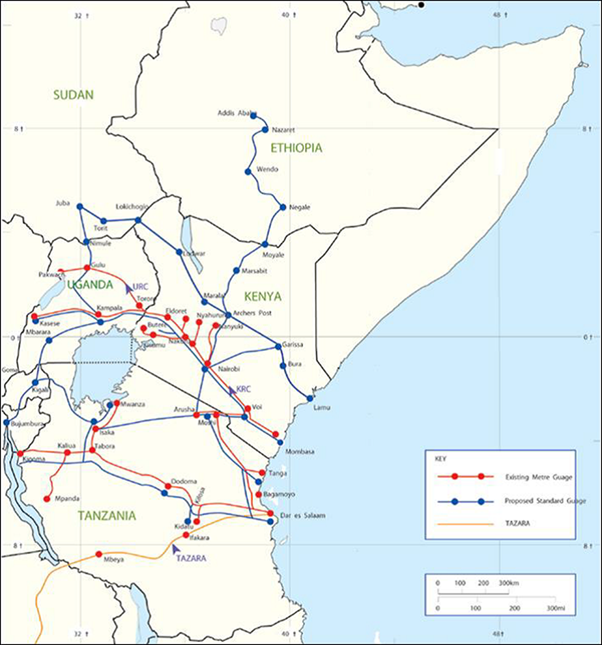
The port occupies 17.5 hectares of land with a stacking area designed to accommodate a throughput of 15,000 TEUs per annum. Similarly, taking Kisumu’s 2014 import figure of 21,943 tons as a starting point, and considering all developments and economic growth, Kisumu’s local cargo imports are estimated to increase to 130,000 tons by 2025, and further to 180,000 tons by 2035. The Port which has been underutilised for over 20 years is in operation after being refurbished at a cost of KES 700 million
Currently, the Port of Kisumu operates only at a fraction of its capacity and former throughput. Due to the deterioration of the rail connection from Mombasa to Kisumu, transit cargo volumes have decreased steeply over the last decades. The port still handles some of the local cargo and specific transit cargo. However, all cargo volumes have dwindled, due to a lack of critical mass and the reliability of the transport system. Lake ports have RoRo ramps, and all break bulk is handled manually. The port of Kisumu exports: Edible Oil, Gas Oil, Steel Billet, bagged fertilizer, ceramic tiles, and assorted nails among other products in small quantities. Exports through the port include sugar, iron sheets, cotton seed cake and Sorghum.
Port website: https://www.kpa.co.ke/OurBusiness/Pages/Kisumu.aspx
|
Port Location and Contact |
|
|---|---|
|
Country |
Kenya |
|
Province or District |
Kisumu County |
|
Nearest Town or City with Distance from Port |
Kisumu 3.4 Km |
|
Port's Complete Name |
Kisumu small Port |
|
Latitude |
0.056000 |
|
Longitude |
34.445999 |
|
Managing Company or Port Authority
|
Kenya Port Authority |
|
Management Contact Person |
Managing Director, Capt. William K Ruto |
|
Nearest Airport and Airlines with Frequent International Arrivals/Departures |
Kisumu international Airport |
Port Picture

Kisumu port facilities are grouped in a wide area of land some 6ha in size including; a 262m quay, a rail-wagon ferry pier, including 90 meters of berthing space alongside the pier, on reclaimed land, almost perpendicular to the main quay, a warehouse measuring 50m by 16m on the main quay, a 3,000 m2 paved storage area directly behind the warehouse, and offices for the harbour master, customs, and police department.
Description and Contacts of Key Companies
Customs and all other key regulatory bodies are available at the port to ensure smooth clearance of cargo.
For more information on port contacts, please see the following link: 4.4 Port and Waterways Companies Contact List.
Port Performance
Cumulative Cargo Through-put Report from 1st August 2017 to Date: -
|
|
2017 |
2018 |
2019 |
2020 |
2021 |
2022 |
2023 |
|---|---|---|---|---|---|---|---|
|
Vessels Reg. |
10 |
7 |
41 |
43 |
77 |
90 |
53 |
|
Export (tons) |
3,431.0 |
9,945.5 |
15,195.7 |
45,550.1 |
52,064.4 |
44,951.9 |
52,550.1 |
|
Import (tons) |
0.0 |
1,000.0 |
2,539.0 |
670.0 |
1,950.0 |
13,338.0 |
8,360.5 |
|
Total (tons) |
3,431.0 |
10,945.5 |
17,734.7 |
46,220.1 |
54,014.4 |
58,289.9 |
60,910.6 |
Average Monthly Vessel Calling & Cargo Through-put
|
No of Vessels |
Export (MT) |
Import (MT) |
Monthly Cum. (MT) |
|---|---|---|---|
|
8 |
7,507 |
1,194 |
8,702 |
Main Export include gas Oil, Steel Billet bagged fertilizer, ceramic tiles, and assorted nails.
Main imports include bagged sugar, iron sheets and sorghum
The Inland Container Depot Kisumu (ICDK) is in Kibos in Western Kenya on the shores of Lake Victoria along the Kibos road in Kondele. The facility is linked to the Port of Mombasa by railtainer service. The volume of cargo handled at the revamped Kisumu port jumped to 17,735 tonnes in 2019, a 62 per cent increase compared to 2018 due to improved efficiency and a surge in trade. Data from Kenya Ports Authority (KPA) shows the volume of cargo shipped through the Kisumu port jumped from 9946 tonnes in 2018 to 58,289 tonnes in 2022 which is a 17% increase. The rise in cargo was buoyed by a strong second-half performance, reflecting better efficiency and an overall improvement in trade among partner states of the East Africa Community (EAC). The number of vessels using the port also increased to 41 in 2019 compared to nineteen the previous year, representing a 116 per cent jump. The upgrading work included concreting of the port yard, construction of the quayside, repairs of the linkspan, revamping the dry dock and rehabilitation of all buildings to boost efficiency. All roads within and the link roads to the port facility have also been repaired and feeder jetties and piers are also being put in place. The port has further been equipped with equipment such as forklift trucks, mobile cranes, and tractor-trailers.
One problem the port has faced in recent decades has been the growth of hyacinth weed, which chokes off a large part of the Kisumu pier and frustrates shipping activities.
The port has been stimulated by the growth in the shipment of goods through the port to destinations in Uganda, Tanzania, Burundi, Rwanda, and Democratic Republic of Congo. Kisumu has also been designated a “city” by the central government of Kenya. Although Kisumu’s rank as a city has not been formalized through a charter by the central government
Port Handling Equipment
The preparedness of Kisumu Lake Port operations was boosted by allocating the following equipment.
|
Equipment |
Available
|
Total Quantity and Capacity Available |
Comments on Current Condition and Actual Usage |
|---|---|---|---|
|
Dockside Crane |
|
|
|
|
Container Gantries |
- |
Not Available |
n/a |
|
Mobile Cranes |
Yes |
1 |
100% operational |
|
Reach stacker |
Yes |
1 |
100% operational |
|
RoRo Tug master (with Trailer) |
- |
Not Available |
|
|
Grain Elevator with Bagging Machines |
- |
Not Available |
|
|
Transtainer |
- |
Not Available |
|
|
Forklifts |
Yes |
4 |
Fifty percent operational |
Terminal Tractor 2, 50% operational
Marine boats 2, 50% operational
-
The equipment is in good working condition.
-
The Kisumu Port was privileged to have two grabs for handling bulk cargo.
Container Facilities
Port facilities are grouped in a wide area of land some 6ha in size. This area includes: a 262m quay, a rail-wagon ferry pier, including ninety meters of berthing space alongside the pier, on reclaimed land, almost perpendicular to the main quay.
Customs Guidance
Upon approval of manifest by customs, the Clearing agent can lodge an entry in the ICMS system for a consignment within the ship. The consignment is inspected by various relevant regulatory agencies and released by customs online after payment of the various duties. If exempted from duty, for exempted consignment approval is done online before final release. Upon clearing with customs, the agent proceeds to settle port charges and release consignment with KPA. Once completed, the port gives a “Pick up Order”/PUO which is effectively the gate pass to allow cargo exit from port. The whole clearing process takes on average two working days hence possible to have all clearance in place by time of ship arrival to facilitate direct delivery upon discharge.
For more information on customs please see the following link: 1.3 Customs Information.
Terminal Information
MULTIPURPOSE TERMINAL
The berth is multipurpose.
GRAIN AND BULK HANDLING
No grain bulk handling facility in Kisumu port
MAIN STORAGE TERMINAL
A warehouse measuring 50m by 16m on the main quay, a 3,000m2 paved storage area directly behind the warehouse, and offices for the harbour master, customs, and police department.
Stevedoring
The stevedoring service is outsourced in an arrangement between the cargo owners and gang representatives.
Hinterland Information
Kisumu port facilitates multimodal cargo transport from rail, road, air, and water. In the year 2023 the port realised a total of 407 trucks loading from the port.
Port Security
The security service is outsourced. (Details awaiting update from KPA)
|
Security |
|
|---|---|
|
ISPS Compliant |
Yes / No |
|
Current ISPS Level |
Insert current level here |
|
Police Boats |
not available |
|
Fire Engines |
not available |
